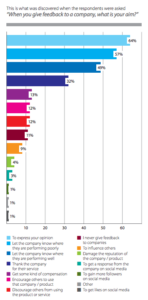A recent survey by Walker Research (Customers 2020: A Progress Report, 2017) highlighted the point that by 2020, customer experience (CX) will overtake price as a key product differentiator. These days, CX can be summed up in one phrase – super connected.
 In last week’s blog, we discussed the merits of disruptive and sustaining technologies, such as Artificial Intelligence (AI), the Internet of Things (IoT) and good old fashioned analytics, which all enable customers to have multi-channel digital interactions with the world – anytime, anyplace, anywhere.
In last week’s blog, we discussed the merits of disruptive and sustaining technologies, such as Artificial Intelligence (AI), the Internet of Things (IoT) and good old fashioned analytics, which all enable customers to have multi-channel digital interactions with the world – anytime, anyplace, anywhere.
Regardless of the various technology platforms customers use to engage with your organisation, they expect consistent and personalised interactions across each channel – such as your landing pages, mobile apps, email/social media pages and campaigns. That means seamless transitions from one digital platform to another.
Customer-experience metrics are everywhere, but relying on them isn’t the same as truly hearing the voice of the customer.
What are the benefits of a connected customer experience?
Understand your customer: Collect and analyse Voice of the Customer (VoC) feedback across all available channels and systems to engage customers along their journey and provide a superior connected customer experience
Get personal: Identify and predict your customers’ needs based on thorough customer data to deliver a frictionless, personalised and consistent experience tailored to their needs and wants—across all channels
Drive innovation: Predict trends and exceed customer expectations
Important KPIs
One of the most important KPIs, for example, in an issue-resolution journey, is the time it takes from issue to resolution. Sounds simple but the size of your organisation vs the speed of response can be a contributing factor to why your customers ‘can’t get no satisfaction!’

 There’s nothing more frustrating than trying to get hold of technical support in a large organisation, or someone in ‘communications’, who only offer boiler plate responses in an automated email or through standard blurb on their website. Of course, there are many use cases (customer journeys), where simple FAQs, How To Guides, Manuals, etc, will do the job of answering a customer query and at the same time, alleviate pressure on your support teams.
There’s nothing more frustrating than trying to get hold of technical support in a large organisation, or someone in ‘communications’, who only offer boiler plate responses in an automated email or through standard blurb on their website. Of course, there are many use cases (customer journeys), where simple FAQs, How To Guides, Manuals, etc, will do the job of answering a customer query and at the same time, alleviate pressure on your support teams.
However, this should never be a substitute for personal contact and meaningful touch points, which ultimately determines whether or not your customers have a one-off, or a continuous relationship with you.
Here at Convert Technologies, we do offer online support documentation and advice, but more importantly, we also offer a direct line to the people who can affect and influence issue resolution in a timely fashion. Our customers are only ever one step away from our technical team, and in some cases, they will be put directly in touch with them, when deemed appropriate to do so.
What’s the difference between Customer Service & Customer Experience?
Many business leaders have finally recognised that delivering ‘experiences’ to customers that consistently meet and exceed customer expectation is ‘good business’. Delivering great customer experiences is now seen as a differentiator, rather than something just that is paid lip service to.
 Breaking it down then – Customer Service is only one cog in the Customer Experience wheel, with choice, accessibility, cost, value for money, and the environment you create for your customers being the all-encompassing framework, that I’m sure we’d all love to get right…. every time.
Breaking it down then – Customer Service is only one cog in the Customer Experience wheel, with choice, accessibility, cost, value for money, and the environment you create for your customers being the all-encompassing framework, that I’m sure we’d all love to get right…. every time.
How many times have you been to a restaurant, to find the most amazingly attentive and ‘on it’ waiting staff you could ever wish to meet? Nothing is too much trouble, your comfort and enjoyment is paramount to them and a smile goes a long way right? Then the food comes out….late…cold…uncooked…wrong order, etc, etc. Not only are you disappointed with the standard of the food preparation, but the place isn’t very clean or hygienic, yet the bill is way up there with a Michelin Star restaurant!
In conclusion – you will not be visiting that restaurant again. In fact, if you were dining in a chain/franchise eatery, it is likely that you will not visit any of that brand of restaurants again. Great customer service, bad customer experience. Same applies if you turn this on it’s head – excellent food served in a stunning environment but with bad customer service, also equals bad customer experience.
There’s no getting away from the fact that everyone in your organisation should be proactively and positively involved in the customer journey, whether operating at the coal face or in the back office. Everyone has to buy into this, or risk breaking the chain.
*I make no apologies for the random song titles dotted around this blog….!
 Why do customers give feedback?
Why do customers give feedback?
 According to a whitepaper by TFM&A Insights, most customers give feedback because they want to express their opinion (64%). More specifically, they do so to let companies know where they were doing poorly (57%), or doing well (49%).
According to a whitepaper by TFM&A Insights, most customers give feedback because they want to express their opinion (64%). More specifically, they do so to let companies know where they were doing poorly (57%), or doing well (49%).
Further research by InMoment’s market insights team found that when asked why they give feedback, four in five consumers stated that they enjoy offering feedback and making a difference. How cool is that?!
There are many benefits to listening to customers’ feedback, particularly gaining customer insight and learning how to improve your product. The feedback from our own customer community has had a huge impact on how our product has developed over the past few years. However, this has only happened through responding, engaging and acting upon the great feedback we’ve received from our customers.
Just because only one person has made a strong suggestion to include a new product feature, doesn’t mean that there aren’t in fact hundreds of others out there who want the same thing, but for whatever reason, don’t have the confidence or inclination to ask.
The Result?
“Time for compliments once again!
Last time I wrote that I hadn’t tried ripping cd’s via Gracenote database as yet. Now, with the weather and/or season changing into autumn and today being German national holiday (which means one day off from work and plenty of time) I did.
The result is great! Especially ripping hybrid sadc’s as well, from pop/rock genre, and also from the classical sector, worked without one single miss by Gracenote tagging. And they’re all sadc’s which weren’t recognised or even kind of refused before.
Switching over to Gracenote was one of the best and most important changes you and/or the team ever installed on Plato. Tending to wordplay, I might venture to say that Gracenote is a grace for the Plato user …Installing YouTube and Exporting Playlists to USB drive were a fine idea too, so thanks for listening!”
Andreas Pathe (Plato owner, Germany)
Ref Sources: Walker Research, Customers 2020: A Progress Report, 2017, www.ijgolding.com, www. virtual-strategy.com, www.kayako.com
#CEX #customerexperience #talktous #opendoor #alwayslistening #feedback #brandloyalty
